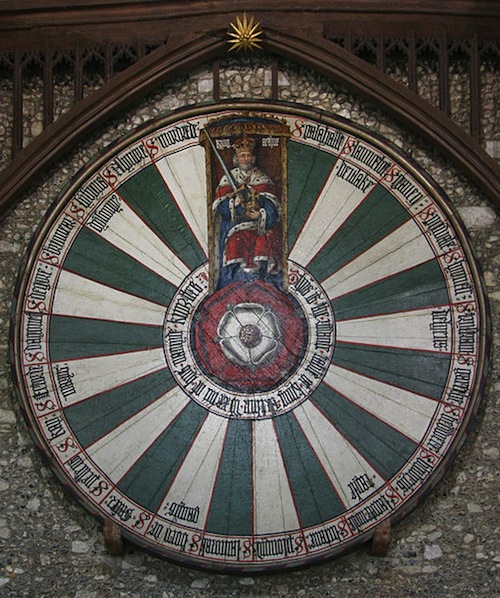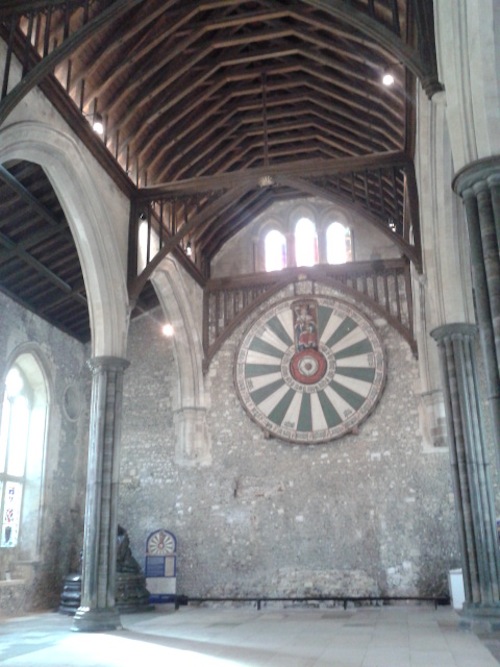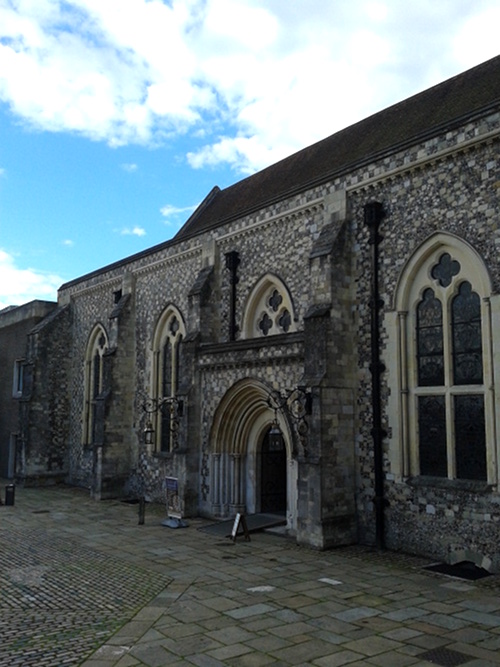The Round Table at Winchester Castle: A Genuine Arthurian Fake

King Arthur and his Knights of the Round Table are shrouded in myth. While stories of their deeds have been popular since the Middle Ages, there’s no hard evidence that they actually existed…
…except that the Round Table hangs in the Great Hall of Winchester Castle!
Well, not really. For centuries it was reputed to have been the genuine article, until archaeologists took it down in 1976 and using radiocarbon and tree ring dating found that it had been made in the 13th or early 14th century, long after King Arthur and his merry knights were supposed to have lived.
Killjoys.
The dates vindicate historians’ long-held belief that the table was made by King Edward I (reigned 1272-1307) around the year 1290 to celebrate the betrothal of one of his daughters. Generally a tournament would be held on such an occasion, and since the chivalry of the day loved to hear stories of Arthurian romance and derring-do, a Round Table would be a fitting decoration. Places around the table are set with the names of Arthur and 24 of his famous knights such as Lancelot and Galahad. One wonders if Edward and his knights actually sat around the table for a feast, and which real-life knights were honored with which places.

The oak table is immense, measuring 5.5 meters in diameter and weighing 1200kg. It appears to have been unchanged since its original construction except for the addition of a Tudor rose during the time of Henry VIII (reigned 1509-1547).
The Round Table hangs inside the Great Hall of Winchester Castle, which is in fact the only part of the castle still standing. William the Conqueror (whom my history professor always referred to as “Billy the Bastard”) first erected a castle here in 1067 as part of an ambitious building program to secure his grip on England. It housed both his Treasury and Exchequer. In the early 13th century the entire castle was renovated and the Great Hall was completed in 1235.

More renovations probably occurred in Edward I’s reign. He was certainly one of England’s great castle builders, and is especially known for the ring of castles he built around his conquests in Wales. He also fought campaigns in Ireland, Scotland, and France. So it’s no surprise that this warrior king would pick the greatest warrior king of all as his model.
While historians have always suspected that Edward I commissioned the Round Table at Winchester, stories soon grew up that it was the real deal. Perhaps these stories were started by Edward himself. They certainly captured the public imagination and there are no doubt some conspiracy theories still today who think the historians have made a great cover up to hide the truth about King Arthur. I bet I could Google it and find some, but I won’t bother. In this case, the real story is just as intriguing as the fiction.
Sean McLachlan is the author of the historical fantasy novel A Fine Likeness, set in Civil War Missouri, and several other titles, including his action series set in World War One, Trench Raiders. His historical fantasy novella The Quintessence of Absence, was published by Black Gate. Find out more about him on his blog and Amazon author’s page.
[…] Black Gate » Blog Archive » The Round Table at Winchester … […]